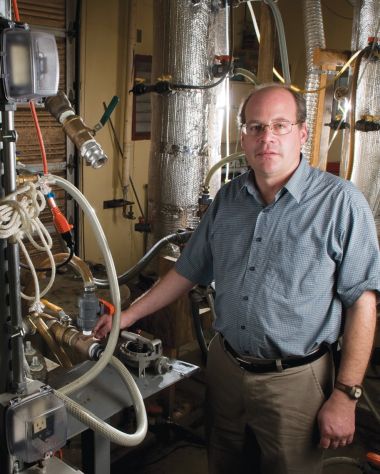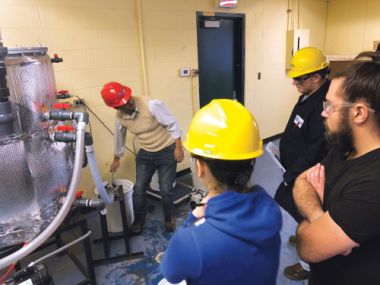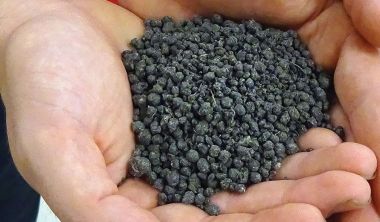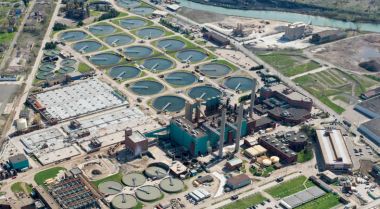It's a Win-Win: Making Detroit's Wastewater Sustainable
- Steven Safferman
- Associate Professor
- Biosystems and Agricultural Engineering
- College of Engineering

Steve Safferman with an anaerobic digester, a unit that uses microbiology to boost the energy producing potential of wastewater biosolids.
Detroit's Water Resource Recovery Facility (WRRF) processes between half and three-quarters of a billion gallons of wastewater a day, more than any other plant in the country. Only a small fraction of that wastewater—one or two percent—is in the form of residuals, called biosolids. But the cost of managing those biosolids—according to Steve Safferman, associate professor in Biosystems and Agricultural Engineering—is quite high.
The Great Lakes Water Authority (GLWA) operates the Detroit WRRF, and is working toward transitioning the plant to increase its use of renewable energy. Safferman is part of a team working with them to develop innovative ways to safely, economically, and sustainably manage the biosolids. "They're very interested in being more sustainable, as well as potentially saving money," said Safferman. "So they're doing a 20-year master plan, which includes looking at what to do to manage these solids. Should they do it any differently than they're doing it now?"
To answer that question, Wendy Barrott, manager of Research and Innovation at GLWA, is working with Safferman and several other MSU researchers on two projects.
The first project looks at converting the biosolids into energy. "GLWA has a long-term goal to become energy neutral," said Barrott. "So that's going to require us to be very energy efficient and also recover energy from the biosolids."
From Biosolids to Sustainable Energy
In nature, converting complex organic materials, like biosolids, to energy happens in geological formations deep underground, where microorganisms anaerobically convert these materials into the natural gas, methane. The goal of Safferman and his partners is to engineer the most efficient, productive, and cost-effective way to replicate this process with the wastewater biosolids. They are testing two methods of making this conversion: microbiologically, using anaerobic digestion, and thermally, using pyrolysis.
According to Safferman, adding other forms of organic waste—such as food waste—to the biosolids, and then using a process called anaerobic digestion, can significantly boost the energy-producing potential. "The microbiology is really complex, but the engineering is very simple," said Safferman. "It's just a big tank with a mixer. And then you have to get the microorganisms and the environment for them to thrive. It's a natural process; we just engineer it to make it more efficient and to be able to collect the gas."

Umesh Adhikari demonstrates components of the anaerobic digestion system to GLWA partners at the Detroit Wastewater Resource Recovery Facility.
After doing a feasibility study to locate and estimate the energy potential of the sources of organic waste within a five to ten mile radius of the plant, Safferman's team needed to determine which organic waste—such as cafeteria food waste—should be tested in the digestion system. They found a commercial waste processing system owned by Waste Management® that takes food waste and turns it into a liquefied form, called Engineered Bioslurry®. According to Safferman, GLWA was excited to try it, and Waste Management® agreed that Detroit may be a potential location for the technology based on preliminary modeling.
What followed was a lot of laboratory testing and preparation for a pilot-scale study. "It looked good on paper, but the microbiology is so complex that you have to try it in the laboratory," explained Safferman. "So we've been running biogas assays. And then, even if it works in the lab, the lab is really small scale, and it doesn't necessarily represent what a big, million-gallon tank would look like. So we built two pilot units for GLWA."
His post-doctoral research associate, Umesh Adhikari, "has been the heart of this project," said Safferman. "He's fantastic, and he's the one who goes back and forth to Detroit a lot." He designed and constructed the pilot-scale units, and is in charge of many of the day-to-day research activities, including the laboratory testing to identify the best feedstock for co-digestion with the biosolids. "Initial results show that the biosolids produced at the Detroit WRRF have ample nutrients for co-digestion with food processing waste," said Adhikari. "A co-digestion with food and food processing waste can substantially increase the biogas production. We would like to test the findings again in the pilot-scale digesters."
Anaerobic digestion is not the only way to derive energy from the biosolids. GLWA is also interested in comparing how much energy can be produced if the biosolids are treated thermally, rather than microbiologically. This thermal process, called pyrolysis, uses high heat to derive primarily gases, as well as biochar (a fine-grained, porous charcoal used in environmental applications). Safferman explains the process: "This method treats the biosolids at high temperatures without oxygen. If we go at high temperatures with oxygen, we combust it; we basically make a flame. If we go at really high temperatures without oxygen, we produce a lot of byproducts and the system can actually be sustainable."
For this part of the project, Safferman has tapped the expertise of colleague Chris Saffron, associate professor in Biosystems and Agricultural Engineering and expert on thermochemical conversion, to do the lab work and thermal degradation studies.

Biochar, a fine-grained, porous charcoal used in environmental applications, is one byproduct of pyrolysis.
The goal is to have a high output of energy in a safe, environmentally-friendly, and cost-effective way. "We have studied the thermal properties of the biosolids, and are in the final phase of completing our thermal conversion study," said Adhikari. "In the thermal conversion process, we did not identify elevated levels of toxic gases, although more analysis is required."
Ultimately, the results of this study will help GLWA determine which type of process—anaerobic digestion or pyrolysis—has the better energy output. "At the end we're going to do an energy balance on both technologies and decide which has the more energy potential, and potentially more profitable technology," said Safferman.
From Biosolids to Safe Fertilizer
Energy recovery isn't the only use for the biosolids. This past June, Safferman and colleague Wei Zhang, associate professor in the Department of Plant, Soil, and Microbial Sciences, received a second grant from GLWA that looks at the land application of biosolids as fertilizer. "GLWA is one of the largest fertilizer providers in the whole region because of the beneficial uses of this fertilizer," said Safferman. "It has lots of nitrogen and phosphorus in it. So the goal is to use these residuals for beneficial purposes. And because of the life-cycle cost of nutrients, repurposing it has potential financial benefit. But the problem is, if we don't do it properly, we can cause issues. And so this follow-up project looks at what happens to the phosphorus when we apply this material and if we prepare it different ways."
The project is still in its early stages, so there are many questions to answer. GLWA's Wendy Barrott is also working with Safferman on this new project and wants to know how the dried biosolids release nutrients in real-world conditions in the soils.
"We think that the phosphorus is really tied up, but we don't know," she said. "We don't know how much nitrogen is available. Steve is going to be doing some column tests with the biosolids in the soils, and then some field work to measure what happens to those nutrients in the soil during the growing season. We want to know if they're fast- or slow-released; do the plants take them up; what goes on with them? We want to know this for our biosolids planning for the future, if continuing what we're doing is a good way to go."
While many of us don't think of Detroit as having a major agricultural impact, this urban/rural integration is important to Safferman. "One thing that I've been talking about is the need to not consider urban, rural, and suburban as separate, that they are absolutely interactive. They can interact negatively and they can interact positively," he said. "So we're trying to develop some concepts and ultimately programs that demonstrate that interconnection. And the GLWA project in Detroit illustrates it better than anything else."
A Collaboration that's a Win-Win

Aerial photo of the Detroit Water and Sewage Department.
Planning for the management of these wastewater biosolids is a big deal—environmentally and economically—for Detroit and Southeast Michigan, and collaborations between industry and academia are critical to the process. "The reason I think these collaborations are important is that we don't have in-house expertise in anaerobic digestion; yet we have a need to understand specifically how anaerobic digestion performs on our particular material," said Barrott. "So we have an expert like Safferman giving us guidance."
Safferman readily acknowledges the two-way benefit. "The partnership is a great example of the university working with a municipal authority to help them out, but also enables us to do state-of-the-art research," he said. "It's not just that we're doing work for them. We're a partnership."
"We're doing a lot of cool things. If we can pull it all together, it'll be great!" said Barrott. "This is our first project being done with our work at the plant. So we're learning so much about what it's going to take to do things, to plan...It's just a learning curve for us and for Steve and everybody."
"This is stuff that I thrive on; it's very holistic," said Safferman. "And it's a compounding benefit: we're saving and making money by getting high-strength waste out of the sewer, which costs a lot of money to treat, and we're also taking it out of the landfill. So I think this is a win-win. If you can make money, and if you can be more sustainable, and if you can reduce greenhouse gases, everybody wins."
- Written by Amy Byle, University Outreach and Engagement
- Photographs courtesy of Steve Safferman, Wade Trim, and DeMaria